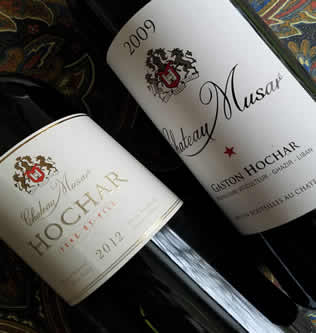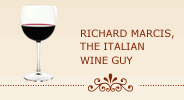The Great Red Wines of Lebanon’s Chateau Musar
It’s all too easy to limit your wine-buying interests to one or more favorite, tried-and-true wine regions like Italy, France and/or Napa, for example. But it’s a big wine world and there’s some pretty good stuff produced in some not especially-well-known regions that fly under the radar screens of the general wine-buying public.
I was reminded of this the other day at a wine tasting that included a few wines from Lebanon that I thought were, well, more than just good, in fact, outstanding. To be honest, until this tasting I never thought much about wines from Lebanon or other Levant countries. I would see some occasionally on the wine lists of middle-eastern restaurants but truth be told I never gave them serious consideration; that is, until recently.
Maybe I shouldn’t be surprised. Lebanon has an ancient winemaking culture dating back thousands of years, long before that of the Greeks and Romans. This vibrant Lebanese wine scene has survived to the present and today there are over 30 wine estates, most of which are centered in and around the country’s historic but turbulent Bekaa Valley.
While there is a lot of competition, Chateau Musar is, hands-down, Lebanon’s most famous and celebrated winery. Established in 1930 by Gaston Hochar it has consistently produced high quality wines despite the economic and political ups-and-downs associated with Lebanon’s tumultuous civil war (1975-1990). It has in fact developed a cult-like following among those-in-the-know for the high quality of its wines and is also popular with wine enthusiasts that favor its non-interventionist, natural approach to winemaking.
All 450 acres of Chateau Musar’s vineyards are certified organic. In the cellar, only natural yeasts are used in fermentation, a bare minimum of sulfites is added and the red wines are not fined or filtered. Chateau Musar has followed this “natural” approach to winemaking long before the term came into vogue. The winery also notes that its wines are “vegan friendly.”
While the winery is located a short distance north of Beirut in the town of Ghazir, its vineyards are over the mountains to the east in the Bekaa Valley. Here they grow primarily classic Bordeaux varieties such as Cabernet Sauvignon, Cinsault, Carignon and Grenache, among others. The Valley receives an abundance of sunshine that facilitates the ripening process. And the high-elevation vineyards – which lie at 2,500 to 3,000 feet asl - experience wide day-night temperature variations that allow the grapes to preserve acidity and develop aromatic complexity.
But it’s the last steps of Chateau Musar’s cellaring operations - the blending and ageing of the wines - that receive the most attention. It’s only after two years of lengthy fermentations and ageing in French oak barriques that the individual varieties are brought together and blended. The blending proportions will vary from year to year depending on winemakers’ assessments of the varietal characteristics of each vintage. After blending, the wines are returned to cement vats for 2 additional years ageing, then bottled (without fining or filtering) and stored in Chateau Musar’s cellars where they age for 4 more years before release for sale.
Think about that. The wine is not released until a full 7 years after harvest. Its not many wineries that have the focus, patience and financial stamina to wait that long so their wines can develop to their full potential before releasing them for sale.
The wines are also very age-worthy and will continue to age gracefully for 10 to 20 years or more. These are indeed singular wines and small wonder they consistently rank among the world’s best.
Chateau Musar has a small portfolio of red, white and rose wines. Below are reviews of two of the estate’s most popular red wines both of which I’ve tasted several times in recent months. Both are readily available in most major U.S. and European wine markets.
Chateau Musar, “Gaston Hochar” Red 2009 (about $55)
The Gaston Hochar Red is Chateau Musar’s flagship wine. It is a Bordeaux-style blend of Cabernet Sauvignon, Carignan and Cinsault harvested from the estate’s vineyards near the villages of Ghazir and Liban in the Bekaa Valley.
As described above, this wine undergoes a lengthy vinification and ageing regimen. The newly-harvested grapes are separately fermented in cement vats after which they are aged in French oak barriques, then blended and returned to cement vats for additional ageing. After a year, the wines are bottled and aged for 4 years before release for sale, a full 7 years after harvest.
 Since the wines are hand-crafted each year to highlight the best characteristics of that vintage there are year-to-year variations in the wines’ aroma and flavor profiles. A Gaston Hochar tasted one year will not necessarily be the same as one tasted the previous year or tasted the next year. The wines also have good ageing potential and their depth of flavors will continue to evolve and become even more intriguing over time. For all these reasons, Musar's Gaston Hochar wines are highly collectable.
Since the wines are hand-crafted each year to highlight the best characteristics of that vintage there are year-to-year variations in the wines’ aroma and flavor profiles. A Gaston Hochar tasted one year will not necessarily be the same as one tasted the previous year or tasted the next year. The wines also have good ageing potential and their depth of flavors will continue to evolve and become even more intriguing over time. For all these reasons, Musar's Gaston Hochar wines are highly collectable.
The 2009 Gaston Hochar is a real pleasure to drink. It is dark plum in color and a gentle swishing of the glass releases raisiny, dark fruit and sweet spice aromas. This is followed by black currant, prunes and some cassis flavors that coat the mouth with pleasing richness and depth. It has a firm structure with good acidity and soft tannins that foretell a long life for this wine despite its already extended ageing. It has a full, grippy finish with a pleasing spiciness. The alcohol is a food-friendly 13.5 percent.
Because the wine is a decade old and was bottled without fining and filtering it will throw sediment. So, before serving it’s best to stand the bottle upright overnight to allow the sediment to settle. After opening, the wine should be decanted for the sediment and then allowed to breath for at least 2 hours prior to serving.
This full-bodied red is an ideal companion for robust dishes like wild game, grilled beef or lamb, full-flavored cheeses and any dish with truffles or caviar.
Chateau Musar, “Hochar Père et Fils” Red 2012 (about $30)
The 2012 Hochar Père et Fils is a blend of primarily Cinsault and Grenache with splashes of Cabernet Sauvignon and Carignan. The grapes are harvested from a single vineyard of 30-year-old vines near the Bekaa Valley village of Aana.
The Hochar Père et Fils Red has some obvious parallels to the estate’s flagship Chateau Musar Red. The four varieties are fermented at controlled temperatures in cement vats and then aged in French oak barriques for 9 months. Afterwards, the wines are blended and bottled unfined and unfiltered. As with the Chateau Musar Red, the blending proportions will vary from year to year reflecting winemakers’ assessments of how the varieties fared in each vintage. After 3 years ageing in the bottle the Hochar Père et Fils Red is released for sale a full 4 years after the harvest.
The Hochar Père et Fils is often referred to as the estate’s “second” wine. But in this case, “second” doesn’t mean “second rate.” Think of it as a younger and more approachable Gaston Musar.
The wine is remarkable for its intense aromatics with ripe dark berry, cherry and fig aromas accented with some cinnamon spiciness. It is full-bodied with good acidity and a firm structure. There are no rough edges here, just an abundance of ripe dark fruit flavors with a spicy edge, smooth tannins and a dry, sleek finish. The alcohol is 14 percent.
This is a regal, complex wine that delivers much more than its rather humble price would suggest. When properly cellared it will age gracefully for a decade or more after the vintage date.
Since the Hochar Père et Fils is bottled without fining and filtering, it should be decanted prior to serving.
While the wines of Chateau Musar have been valued by wine cognoscenti for decades they are just now starting to be recognized and appreciated by the general wine-buying public. These two reds are well worth seeking out on your next wine-shopping excursion.
©Richard Marcis
February 5, 2019
Return to Wine Reviews and Musings
Return to italian wine reviews
Help keep this website ad-free and independent.
Consider making a contribution to support the work of WineWordsWisdom.com.


